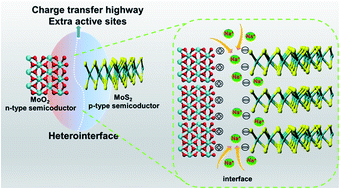Tailored nanoscale interface in a hierarchical carbon nanotube supported MoS2@MoO2-C electrode toward high performance sodium ion storage†
Abstract
Tailoring heterointerfaces at atomic and molecular levels in electrode materials for superior structural stability and enhanced power/energy densities is desired yet still challenging for achieving ultrafast and stable Na-ion batteries. Herein, an MoS2/MoO2 heterointerface is designed and created, in which ultrafine MoO2 nanocrystals are tightly anchored on ultrathin MoS2 nanosheets, with the assistance of an N-doped carbon protecting layer, on flexible carbon nanotubes. The electrode exhibits a high specific capacity of ∼700 mA h g−1 at 0.2 A g−1 and an ultra-long cycling stability over 6000 cycles at 5 A g−1. Moreover, an excellent rate capability of ∼375 mA h g−1 at 10 A g−1 is retained. As evidenced by both experiments and density functional theory (DFT) calculations, the heterointerface could not only introduce an electric field to reduce the charge transport barrier, but also provide extra active sites to adsorb Na+. Meanwhile, within the designed nanoarchitecture, the MoO2 nanocrystals can effectively reduce the aggregation of MoS2 during charge/discharge processes, and adsorb polysulfide to improve the reversibility. This work provides a fundamental understanding of engineering heterointerfaces at the atomic level for enhanced Na+ storage and transport, which can be extended to other functional electrode materials.



 Please wait while we load your content...
Please wait while we load your content...